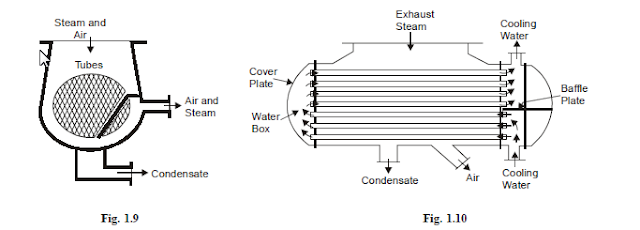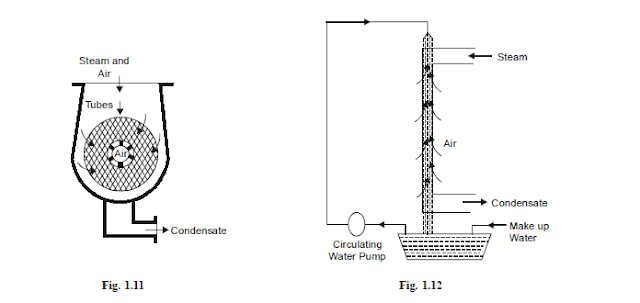Steam Condenser
Thermal efficiency of a closed cycle power developing system using steam as working fluid and
working on Carnot cycle is given by an expression (T1 – T2)/T1. This expression of efficiency shows that
the efficiency increases with an increase in temperature Tl and decrease in temperature T2. The maximum
temperature T1 of the steam supplied to a steam prime mover is limited by material considerations.
The temperature T2 (temperature at which heat is rejected) can be reduced to the atmospheric temperature
if the exhaust of the steam takes place below atmospheric pressure. If the exhaust is at atmospheric
pressure, the heat rejection is at 100°C.
Low exhaust pressure is necessary to obtain low exhaust temperature. But the steam cannot be
exhausted to the atmosphere if it is expanded in the engine or turbine to a pressure lower than the
atmospheric pressure. Under this condition, the steam is exhausted into a vessel known as condenser
where the pressure is maintained below the atmosphere by continuously condensing the steam by means
of circulating cold water at atmospheric temperature.
A closed vessel in which steam is condensed by abstracting the heat and where the pressure is
maintained below atmospheric pressure is known as a condenser. The efficiency of the steam plant is
considerably increased by the use of a condenser. In large turbine plants, the condensate recovery becomes
very important and this is also made possible by the use of condenser.
Types Steam Condenser
Steam condenser are of two types:
1. Surface condenser. 2. Jet condensers
1. Surface condenser:
In surface condensers there is no direct contact between the steam and cooling water and the condensate can be re-used in the boiler: In such condenser even impure water can be used for cooling purpose whereas the cooling water must be pure in jet condensers. Although the capital cost and the space needed is more in surface condensers but it is justified by the saving in running cost and increase in efficiency of plant achieved by using this condenser. Depending upon the position of condensate extraction pump, flow of condensate and arrangement of tubes the surface condensers may be classified as follows:
(i) Down flow type. Fig. 1.9 shows a sectional view of dawn flow condenser. Steam enters at the
top and flows downward. The water flowing through the tubes in one direction lower half comes out in
the opposite direction in the upper half Fig. 1.10 shows a longitudinal section of a two pass down-flow condenser
(ii) Central flow condenser. Fig. 1.11 shows a central flow condenser. In this condenser the
steam passages are all around the periphery of the shell. Air is pumped away from the centre of the
condenser. The condensate moves radially towards the centre of tube nest. Some of the exhaust steams while moving towards the centre meets the undercooled condensate and pre-heats it thus reducing undercooling.
(iii) Evaporation condenser. In this condenser (Fig. 1.12) steam to be condensed is passed
through a series of tubes and the cooling waterfalls over these tubes in the form of spray. A steam of air flows over the tubes to increase evaporation of cooling water, which further increases the condensation of steam.
ADVANTAGES AND DISADVANTAGES OF A SURFACE CONDENSER
The various advantages of a surface condenser are as follows:
1. The condensate can be used as boiler feed water.
2. Cooling water of even poor quality can be used because the cooling water does not come in
direct contact with steam.
3. High vacuum (about 73.5 cm of Hg) can be obtained in the surface condenser. This increases
the thermal efficiency of the plant.
The various disadvantages of’ the surface condenser are as follows:
1. The capital cost is more.
2. The maintenance cost and running cost of this condenser is high.
3. It is bulky and requires more space.
REQUIREMENTS OF A MODERN SURFACE CONDENSER
The requirements of ideal surface condenser used for power plants are as follows:
1. The steam entering the condenser should be evenly distributed over the whole cooling surface
of the condenser vessel with minimum pressure loss.
2. The amount of cooling water being circulated in the condenser should be so regulated that the
temperature of cooling water leaving the condenser is equivalent to saturation temperature of
steam corresponding to steam pressure in the condenser.
This will help in preventing under cooling of condensate.
3. The deposition of dirt on the outer surface of tubes should be prevented.
Passing the cooling water through the tubes and allowing the steam to flow over the tubes achieve
this. 4. There should be no air leakage into the condenser because presence of air destroys the vacuumin the condenser and thus reduces the work obtained per kg of steam. If there is leakage of air
into the condenser air extraction pump should be used to remove air as rapidly as possible.
2. JET CONDENSERS
In jet condensers the exhaust steam and cooling water come in direct contact with each other.
The temperature of cooling water and the condensate is same when leaving the condensers.
Elements of the jet condenser are as follows:
1. Nozzles or distributors for the condensing water.
2. Steam inlet.
3. Mixing chambers: They may be (a) parallel flow type (b) counter flow type depending on
whether the steam and water move in the same direction before condensation or whether the
flows are opposite.
4. Hot well.
In jet condensers the condensing water is called injection water.
TYPES OF JET CONDENSERS
1. Low level jet condensers (Parallel flow type). In this condenser (Fig. 1.13) water is sprayed
through jets and it mixes with steam. The air is removed at the top by an air pump. In counter flow type of condenser the cooling water flows in the downward direction and the steam to be condensed moves upward.
2. High level or Barometric condenser. Fig. 1.14 shows a high-level jet condenser. The condenser
shell is placed at a height of 10.33 m (barometric height) above the hot well. As compared to low
level jet condenser. This condenser does not flood the engine if the water extraction pump fails. A
separate air pump is used to remove the air.
3. Ejector Condenser. Fig. 1.15 shows an ejector condenser. In this condenser cold water is discharged under a head of about 5 to 6 m through a series of convergent nozzles. The steam and air enter the condenser through a non-return valve. Mixing with water condenses steam. Pressure energy is partly convert into kinetic energy at the converging cones. In the diverging come the kinetic energy is partly converted into pressure energy and a pressure higher than atmospheric pressure is achieved so as to discharge the condensate to the hot well.




I really like your writing style, superb info, thanks for putting up
:D.
Dear Sir/Ms,
Our company (RAAD Engineering Co) is about to start a new project in generating electricity via Distributed Generation. We plan to generate about 10 MW using steam turbine. Our boiler would be something with the following specifications:
Value: 80 Tons
Pressure: 22 bar
Temperature: 360 °C
Since we are at the beginning phase and we must work on the budget allocated for the project, would you please give me some information about the type of condenser that meet our needs and the best price that you can provide?
If you had any question, please don’t hesitate to ask.
Thanks in advance
Hadi Ghanei